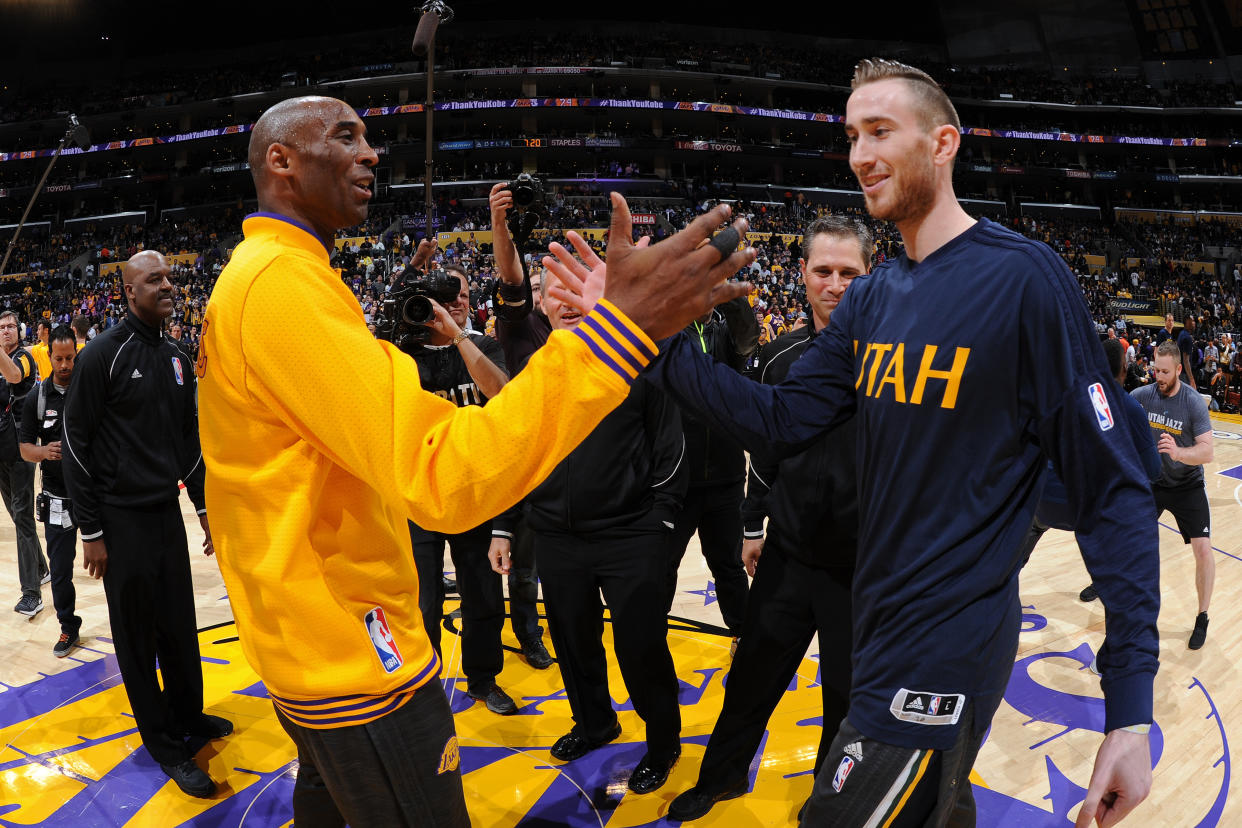Kobe Bryant shares words of encouragement for Gordon Hayward after horrific injury

The NBA world recoiled in horror midway through the first quarter of the first game of the 2017-18 season after watching Gordon Hayward suffer a frightening dislocated left ankle and fractured tibia. Less than six minutes into his first game after signing a four-year, $128 million maximum-salaried contract with the Boston Celtics in free agency, the 27-year-old All-Star went up for an alley-oop and came down all wrong, landing in a heap in the lane and shaking a Celtics team with championship aspirations to its core.
[Now’s the time to sign up for Fantasy Basketball! Join for free]
Players, coaches and teams across the NBA rushed to share their support for Hayward, and their best wishes for a speedy recovery. One player who knows all too well how grueling and difficult it can be to come back from a serious leg injury — retired legend Kobe Bryant — waited until Wednesday morning before offering some advice for Hayward to keep in mind as he begins his journey down the comeback trail:
The caption of Bryant’s Instagram post:
Be sad. Be mad. Be frustrated. Scream. Cry. Sulk. When you wake up you will think it was just a nightmare only to realize it’s all too real. You will be angry and wish for the day back, the game back, THAT play back. But reality gives nothing back and nor should you. Time to move on and focus on doing everything in your power to prepare for surgery, ask all the questions to be sure you understand fully the procedure so that you may visualize it in your subconscious while being operated on and better the chance of it’s success. Then focus on the recovery process day by day by day.
It’s a long journey but if you focus on the mini milestones along the way you will find beauty in the struggle of doing simple things that prior to this injury were taken for granted. This will also mean that when you return you will have a new perspective. You will be so appreciative of being able to stand, walk, run that you will train harder than you ever have. You see the belief within you grow with each mini milestone and you will come back a better player for it. Best of luck to you on this journey my brother #mambamentalityalways.
Bryant learned firsthand how hard it can be to go from the peak of your powers to unable to stand when he suffered a ruptured left Achilles tendon in April of 2013. The repair and rehabilitation process took everything Mamba had; it took him three months just to get back to walking, and nearly eight months to get back to playing and dunking.
As taxing as it was, Bryant would later express his appreciation for what the process taught him, for how it helped mold his perspective as a prospective storyteller — “It’s the ugly moments that create the beauty at the end of the film.” And, as Hayward saw firsthand as a member of the Utah Jazz, Kobe was able to write a pretty beautiful ending, nearly three years to the day after he went down in agonizing pain.
[Follow Ball Don’t Lie on social media: Twitter | Instagram | Facebook | Tumblr]
With Bryant’s advice in place, Hayward will soon begin the process of healing, and face the challenge of returning. How long that process will take remains unclear, pending further evaluation of his injury and a decision on how best to proceed. According to Jeff Stotts of the injury-focused site In Street Clothes, an educated guess suggests Hayward is in for, at best, “a prolonged absence:”
Determining how long Hayward will be sidelined is difficult as injuries of this magnitude rarely have a good comparison, especially in the NBA. Initial associations to Paul George’s gruesome leg injury during the summer of 2014 are natural but the two injuries are drastically different. George’s injury was an open fracture of both the tibia and the fibula. Though a rod was eventually inserted to stabilize the fracture site, the break actually occurred in a favorable location. By breaking the bones near the mid-shaft, George was able to avoid extensive ligament and tendon damage.
However, it is unlikely Hayward was as fortunate. His break occurred at the distal end of the tibia, a site that serves as an anchor site for multiple ligaments. Furthermore, it is rare that a dislocation occurs without some level of ligament or soft tissue damage. Damage to the articular cartilage of the talus must also be considered.
Surgery to fix the area will likely involve surgical screws and a plate, not a rod. These implants help stabilize the injury site as the associated ligament damage heals. Any complex ligament injuries may need to be surgically addressed as well.
However Hayward and the Celtics’ medical team choose to proceed, it’s clear that the eighth-year veteran has a long road ahead of him. To whatever extent they can, here’s hoping Bryant’s words of support will help make traveling it a little bit easier.
– – – – – – –
Dan Devine is an editor for Ball Don’t Lie on Yahoo Sports. Have a tip? Email him at devine@yahoo-inc.com or follow him on Twitter!
More from Yahoo Sports:
• McKayla Maroney: I was molested by team doctor
• New Celtics star suffers horrific injury in opener
• Angry fan gives Cowboys owner an earful
• Cubs fans trolled by Dodgers fans for leaving early



